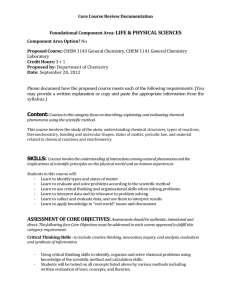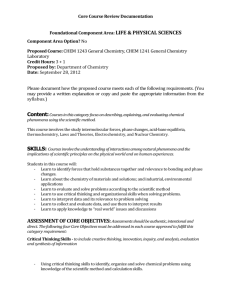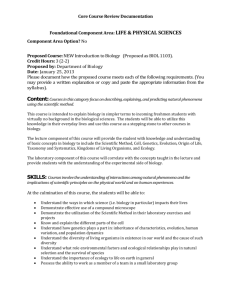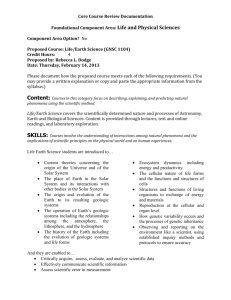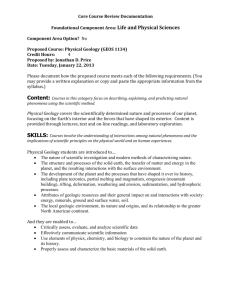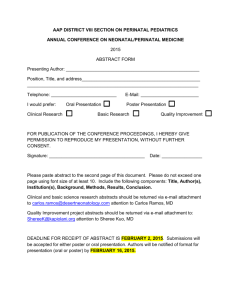observations construct
advertisement
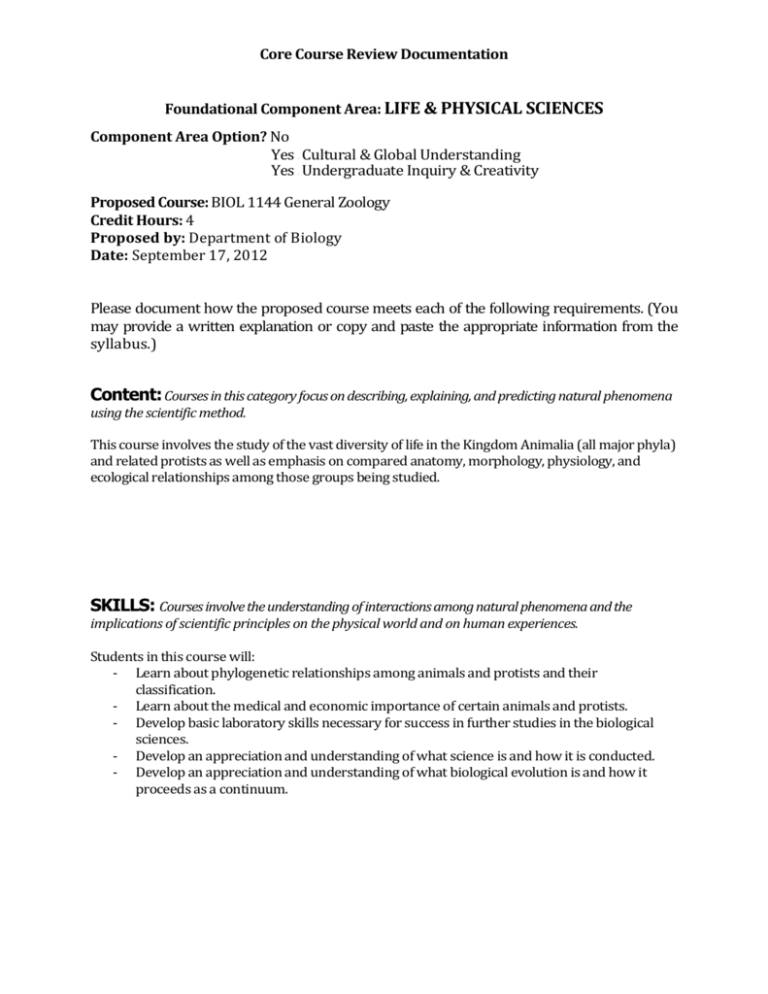
Core Course Review Documentation Foundational Component Area: LIFE & PHYSICAL SCIENCES Component Area Option? No Yes Cultural & Global Understanding Yes Undergraduate Inquiry & Creativity - - Proposed Course: BIOL 1144 General Zoology Credit Hours: 4 Proposed by: Department of Biology Date: September 17, 2012 Please document how the proposed course meets each of the following requirements. (You may provide a written explanation or copy and paste the appropriate information from the syllabus.) Content: Courses in this category focus on describing, explaining, and predicting natural phenomena using the scientific method. This course involves the study of the vast diversity of life in the Kingdom Animalia (all major phyla) and related protists as well as emphasis on compared anatomy, morphology, physiology, and ecological relationships among those groups being studied. SKILLS: Courses involve the understanding of interactions among natural phenomena and the implications of scientific principles on the physical world and on human experiences. Students in this course will: - Learn about phylogenetic relationships among animals and protists and their classification. - Learn about the medical and economic importance of certain animals and protists. - Develop basic laboratory skills necessary for success in further studies in the biological sciences. - Develop an appreciation and understanding of what science is and how it is conducted. - Develop an appreciation and understanding of what biological evolution is and how it proceeds as a continuum. Core Course Review Documentation ASSESSMENT OF CORE OBJECTIVES: Assessments should be authentic, intentional and direct. The following four Core Objectives must be addressed in each course approved to fulfill this category requirement: Critical Thinking Skills - to include creative thinking, innovation, inquiry, and analysis, evaluation and synthesis of information - Using the exercise for performing quantitative skills (attachment: Metric Measurement and the Scientific Method), the scientific method will be incorporated in which the students make observations, construct hypotheses, make precise measurements, test hypotheses, and evaluate data they collected. This will be assessed based on the grading of the exercises. Student introduction to using the scientific method and applying it to a simplistic situation as presented in the exercise should inherently help students in the development of critical thinking skills that are intrinsic to science. - This exercise will be used to determine if a student has exceeded the “benchmark” status of critical thinking as set by the AACU in their Critical Thinking VALUE rubric (attached). This includes identifying a problem, gathering data/evidence, developing their own hypothesis, testing their hypothesis, forming conclusions based on the data and outcome of their testing. This is the level of expectation of achievement in the sciences for a freshman core class concerning this learning objective. Communication Skills - to include effective development, interpretation and expression of ideas through written, oral, and visual communication - Students will conduct poster presentations about an animal or protist that was not covered in class or lab. A standardized rubric will be used to assess the communication skills required for assembling and presenting the poster (attachment: General Zoology Poster Presentation). - These assessment tools will be used to determine if a student has exceeded the “benchmark” status of written, oral, and visual communication as set by the AACU in their Written and Oral Communication VALUE rubrics (attached). This includes numerous aspects of these objectives such as organization, use of sources as support, use of proper scientific language, informative writing, etc. This is the level of expectation of achievement in the sciences for a freshman core class concerning these learning objectives. Core Course Review Documentation Empirical and Quantitative Skills - to include the manipulation and analysis of numerical data or observable facts resulting in informed conclusions - Students will perform an exercise involving metric conversions, measurements and calculations of quantitative data while incorporating the scientific method (attachment: Metric Measurement and the Scientific Method). Grading of the exercise will be used for assessment. - This exercise will be used to determine if a student has demonstrated at least the “benchmark” status of quantitative skills as set by the AACU in their Quantitative Literacy VALUE rubric (attached). This includes ability to calculate, interpret numerical data, convert, represent, and communicate numerical data through tables and graphs, and use numerical data to make and support a point. This is the level of expectation of achievement for a freshman core class concerning this learning objective. Teamwork - to include the ability to consider different points of view and to work effectively with others to support a shared purpose or goal - Students will work in groups to construct and present posters. Students will be grouped by random selection to develop fair, unbiased groupings of students. - Students will each evaluate their perceived percentage contribution to the poster by each student in their group as well as themselves. Students will also assess the quality of contribution to the poster by each student in their group as well as themselves. This will incorporate a “self-assessment” component of teamwork (attachment: Student Evaluation of Contribution to Poster Presentation). This individual assessment for teamwork will be incorporated into the grading rubric for poster presentations (attachment: General Zoology Poster Presentation). - Students will work in groups while performing observations of preserved and living protist and animal specimens under the microscope as well as while conducting dissections of select animal specimens throughout the semester. Laboratory teaching assistants will observe students’ group performance over the course of the semester and subjectively assess that performance based on observations of the students to assign a grade for teamwork at the end of the semester (attachment: TA Evaluation of Student Teamwork in a Course). - These assessment tools will be used to determine if a student has demonstrated at least the “benchmark” status of teamwork as set by the AACU in their Teamwork VALUE rubric (attached). This includes sharing ideas, exhibiting collegiality, and showing responsibility in completing a task by deadline within a group. This is the level of expectation of achievement for a freshman core class concerning this learning objective. Core Course Review Documentation ADDITIONAL INFORMATION: Provide any additional information supporting course inclusion in the core (optional). PLEASE ATTACH THE FOLLOWING 1. 2. 3. 4. 5. Syllabus Assessment for Critical Thinking Skills Assessment for Communication Skills Assessment for Empirical & Quantitative Skills Assessment for Teamwork
